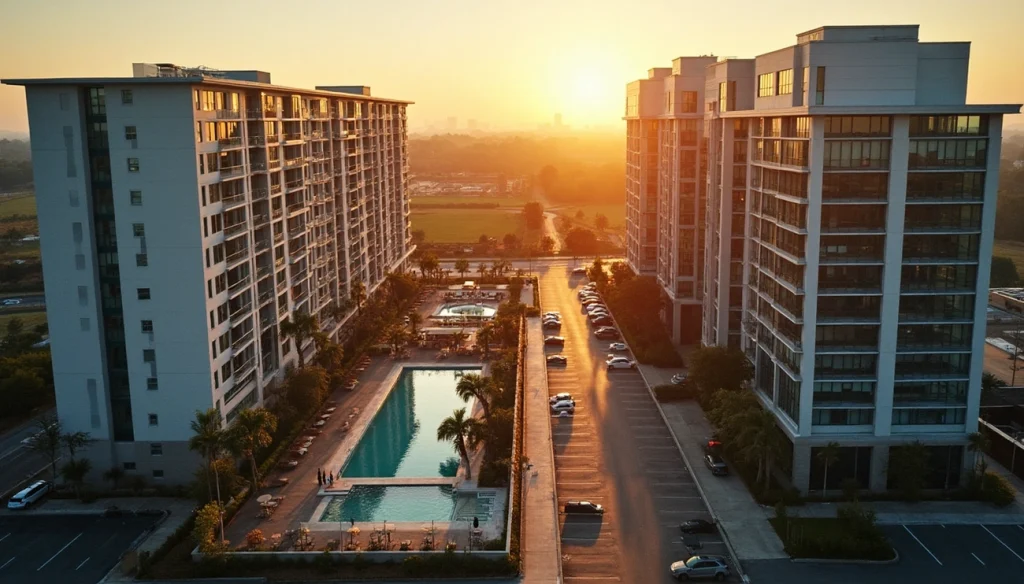Investors in real estate must choose between multifamily commercial real estate and industrial properties to build long-term wealth. These asset classes have showed excellent performance records that attract substantial institutional capital. Sophisticated investors seeking portfolio growth find both options compelling. Several factors affect potential returns and risk profiles, which need careful analysis before making a decision.
Warehousing and multifamily development sectors remain strong due to e-commerce growth and demographic changes. Performance metrics, property management needs, and risk factors for each asset class deserve a thorough review to help investors shape their real estate strategy effectively. Investors can schedule a strategy consultation to receive customized guidance about their portfolio goals.
Market Performance and Trends
Commercial real estate markets show striking differences between multifamily and industrial sectors’ performance. Market data highlights major changes in both asset classes and creates unique opportunities for strategic investors.
Recent growth in multifamily and industrial sectors
The multifamily sector has seen substantial supply growth, with over 1 million rental units in the national supply pipeline that represents a 75% increase since 2019. The market needed some adjustments as vacancy rates climbed from 4.7% in Q3 2021 to 6.8% in 2023. The industrial sector showed remarkable resilience and achieved a historic low vacancy rate of 3.2% in Q4 2021.
What we just need for each asset class
Market forces uniquely shape the trajectory of both sectors:
- What Drives Multifamily Growth:
- Households continue to grow alongside steady wage increases
- Many people cannot afford single-family homes
- Sun Belt markets experience significant population growth
- Industrial Growth Factors:
- E-commerce could represent 30% of all sales by 2030
- Third-party logistics companies will likely occupy 35% of industrial spaces
- Modern distribution centers are essential
Projected market outlook
Both sectors show positive outlook with different growth patterns. Multifamily rent growth will stabilize at 1.2% in 2024, and markets will just need an additional 1 billion square feet of industrial space over the next five years to meet e-commerce demands.
Sun Belt markets demonstrate dynamic growth despite temporary adjustments, and regional differences play a significant role. Strong job growth projections support sustained long-term demand in markets with the largest supply pipelines like Austin, Dallas, Nashville, and Atlanta.
Understanding each sector’s unique dynamics helps investors capitalize on these market trends. Schedule a strategy consultation to see how these market trends line up with your investment goals.
Investment Returns and Cash Flow
A thorough analysis of investment returns across real estate sectors depends on key performance metrics. The latest market data explains how multifamily and industrial properties perform relative to each other.
Typical cap rates for multifamily vs industrial
The latest data reveals cap rates of 5.2% for industrial properties, while multifamily properties yield 5.3%. Both sectors demonstrate robust market fundamentals, and their cap rates have risen by about 0.8% from Q2 2022 to Q3 2023. The minimal difference between these sectors suggests risk-adjusted return profiles that are like in each other, which makes them compelling choices for institutional investors.
Cash flow potential and predictability
These assets show very different cash flow patterns in terms of stability and growth potential. Multifamily properties are a great way to get steady income through several key benefits:
- Multiple tenant revenue streams that reduce vacancy effects
- A chance to earn extra income from amenities and services
- Knowing how to adjust rents often with short-term leases
- Cost savings from operational scale
Industrial properties come with longer lease terms and tenants with stronger credit ratings. This setup creates more predictable long-term cash flows, though it’s nowhere near as flexible as multifamily properties when market rents increase.
Long-term appreciation prospects
Market forces drive strong appreciation potential in both sectors. Housing supply challenges in urban areas create sustained pressure on multifamily properties. The industrial sector’s growth comes from e-commerce expansion and the need for sophisticated distribution networks.
Value-add opportunities can improve returns in both sectors by a lot. Smart improvement strategies lead to higher cash flows and better sale prices. But investors should remember that development projects might affect cash flow temporarily during improvements.
To optimize your real estate portfolio allocation between these sectors, schedule a strategy consultation that aligns with your investment goals and market opportunities.
Management and Operational Considerations
Operational efficiency is a vital factor that shapes how real estate investments perform over time. Investors face unique challenges and opportunities when they manage industrial properties compared to multifamily properties.
Tenant turnover and lease structures
Tenant behavior patterns affect how efficiently properties operate. Multifamily properties face more frequent tenant changes that cost $1,825 per vacant unit. Industrial properties show better stability because tenants commit to 3-year terms instead of the yearly leases common in multifamily units. These lease duration differences shape property stability and determine how much management attention each type needs.
Property management requirements
Different asset classes need varying levels of management intensity. The core team faces these operational differences:
- Tenant Volume: A multifamily property needs to manage about 60 tenants for each similar-sized asset. Industrial properties are easier to handle with just 2-5 tenants
- Daily Operations: Industrial assets work well with automated and outsourced management. Multifamily properties need staff on-site all the time
- Lease Administration: Industrial properties have simpler lease management because they have fewer tenants and use standardized triple-net (NNN) lease structures
Maintenance and capital expenditures
The way capital expenditures work creates a major difference in operations. Industrial property owners pass their maintenance duties to tenants through triple-net lease arrangements. However, multifamily owners must handle all property maintenance and improvements themselves. Their responsibilities include essential building components like roofing, electrical systems, and plumbing.
Multifamily properties need sophisticated systems and a core team to manage complex operations, which affects the overall returns. Property investors who want to streamline their portfolio should schedule a strategy consultation to explore these management aspects thoroughly.
Risk Factors and Mitigation Strategies
Smart investors know that detailed risk assessment are the foundations of lasting wealth creation in real estate. The multifamily and industrial sectors show different risk profiles that need careful evaluation and management.
Market-specific risks for each asset class
Latest data reveals multifamily properties now face higher vacancy rates, which jumped from 4.6% to 7% since mid-2021. The sector struggles as developers plan to complete 440,000 new units in 2024. Industrial properties maintained stability historically but remain vulnerable to e-commerce trends and supply chain disruptions.
Both sectors share these significant risk factors:
- Oversaturated markets in developing regions
- Changes in tenant priorities and needs
- Regional economic performance
- Essential access and reliable infrastructure
Economic and regulatory risks
Real estate investors face most important challenges in the regulatory environment. Multifamily property operations now encounter heightened oversight, and rising instances of fraud and cybersecurity threats create fresh operational concerns. Property developers must address environmental regulations and zoning restrictions that affect industrial development and operations.
Market data reveals that housing providers’ insurance premiums surged by 25% during 2022-23 renewals, affecting 29% of providers. Investment returns face mounting pressure from this cost increase coupled with interest rate fluctuations.
Diversification benefits
Smart diversification in both sectors can significantly reduce risks. Multi-tenant industrial properties show lower vacancy risk than single-tenant assets. Multifamily investments protect your portfolio through:
- Geographic market diversification
- Tenant base diversification
- Income stream stability
You can make your portfolio more resilient with smart risk management strategies. A complete due diligence process, professional property management and regular market analysis will help achieve this goal. Our expert team can help you build a better real estate investment strategy – schedule a consultation today.
Conclusion
Long-term wealth creation comes through multifamily and industrial real estate investments that follow different paths with strong market fundamentals and unique benefits. Both sectors show cap rates close to 5.3%. The main difference lies in operations – multifamily needs management of many residential tenants while industrial properties have fewer occupants. These sectors stay strong through market cycles. Multifamily properties let owners adjust rents while industrial assets provide steady cash flow through triple-net leases.
Smart investors need to think about market timing, operational skills, and risk tolerance when splitting their portfolio between these sectors. Expert guidance is a great way to get clarity with these complex investment choices. Our expert team can help you arrange a customized plan that matches your wealth-building goals. Schedule a strategy consultation with us today. Both sectors remain solid options for smart investors who grasp their benefits and challenges in today’s changing market.















